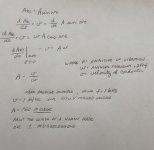The earth spinning on its axis and background micro vibrations is also a source. Where is the proof any of it changes sound? You are speaking of controlling vibrations but offer no proof that it makes a difference. It’s like a mousetrap for a fictional or folklore pest?
You neglected to mention that the earth is revolving at the Equator at 1000 mph, the earth is orbiting the sun at 66k mph, and the galaxy is traveling thru the universe at 450k mph. Ever hear of the phrase, still waters? Think that phrase is folklore? Please pour yourself a glass of water and let it settle on the counter and then study it closely for any visual movement. Then again, nothing is entirely stable, is it?
I should note again that it's impossible to isolate any ojbect from all sources of vibration simultaneously. And if one successfully isolates vibrations from one source, then inherently the vibrations from at least one other source remain trapped.
But the bottom line is, unwanted energy can never be isolated or squashed but it can be redirected before it induces its catastrophic harm. Exactly like lightning and a lightning rod, grounding wire, and grounding spike.
BTW, I've already provided a few in-room videos but remember that you're a music lover first.
The folklore lies with the vibration isolation method. In fact, when taken to the extreme, the resonant energy transfer methodology (the one true methodology) I employ not only exposes the vibration isolation method for what it is not, it also potentially exposes about 10 other very popular folklore in high-end audio.
I have better examples but in this video which was already posted, the in-room volume levels were about 104db peak. Most other playback systems start to fall apart long before reaching that volume level. The format is DVD - roughly the equivalent to the supposedly inferior Redbook format. The playback system itself i.e. the source, the amps, subwoofer, and speakers combined retailed new for $11k - which is chump change by today's standards (excluding the $17k invested in extreme forms of electrical and mechanical energy mgmt). But compare this level of musicality to any playback system at any cost. Also, there is no active linestage and yet the dynamics are perhaps more natural and realistic than any active linestage could offer.
Even though this in-room video is a counterfeit of a counterfeit of a counterfeit of the original live performance and you may be listening to it via headphones, listen closely and carefully consider whether your listening perspecive is in the listening room or somewhere / anywhere inside the concert hall. That's because soooo much more music info remains audible above the system's drastically lowered noise floor rather than inaudible below a much raise noise floor. In this video you should be hearing volumes more of the live peformance's ambient info (the lowest of all low-level detail) at the speaker that vibration isolation makes inaudible. I'm guessing you'd be pretty hard-pressed to point me toward another playback system at any price with this level of musicality, dynamics, and sense of realism especially at these volume levels.
I should also note that my just barely reasonble enough listening room contains no acoustic treatments or bass traps which is more folklore. IOW, with the vibration mgmt methodology I employ so much more music info remains audible at the speaker (due to a drastically lowered system noise floor) that most/all room acoustic anomalies are so completely overshadowed, that the room is essentially gone and now your listening perspective should be somewhere / anywhere in the recording hall. This applies to most any inferior-engineered recording including those from the 50's, 60's, etc.
Lastly, I care zero about floor-borne vibrations which is just more folklore required for isolaiton folklore to exist and have purpose. My subwoofer is about 2ft to the right of my custom racking system in the vdieo. Both are coupled firmly to the subflooring and may even share the same floor joist. That's how much I care about floor-borne vibrations and my routine listening near / at live performance volume levels is just more proof that I don't care about floor-borne vibrations. I also don't care about air-borne vibrations or at least I don't think I care. What I do care about is the multitude of internally-generated vibrations or resonant energy induced by electric current flow that establishes a playback system's much raised noise floor perhaps the moment we push the power on button. The one energy type nobody else seems to care about.
And be sure to crank up the volume to ensure you get the fullest effect.

